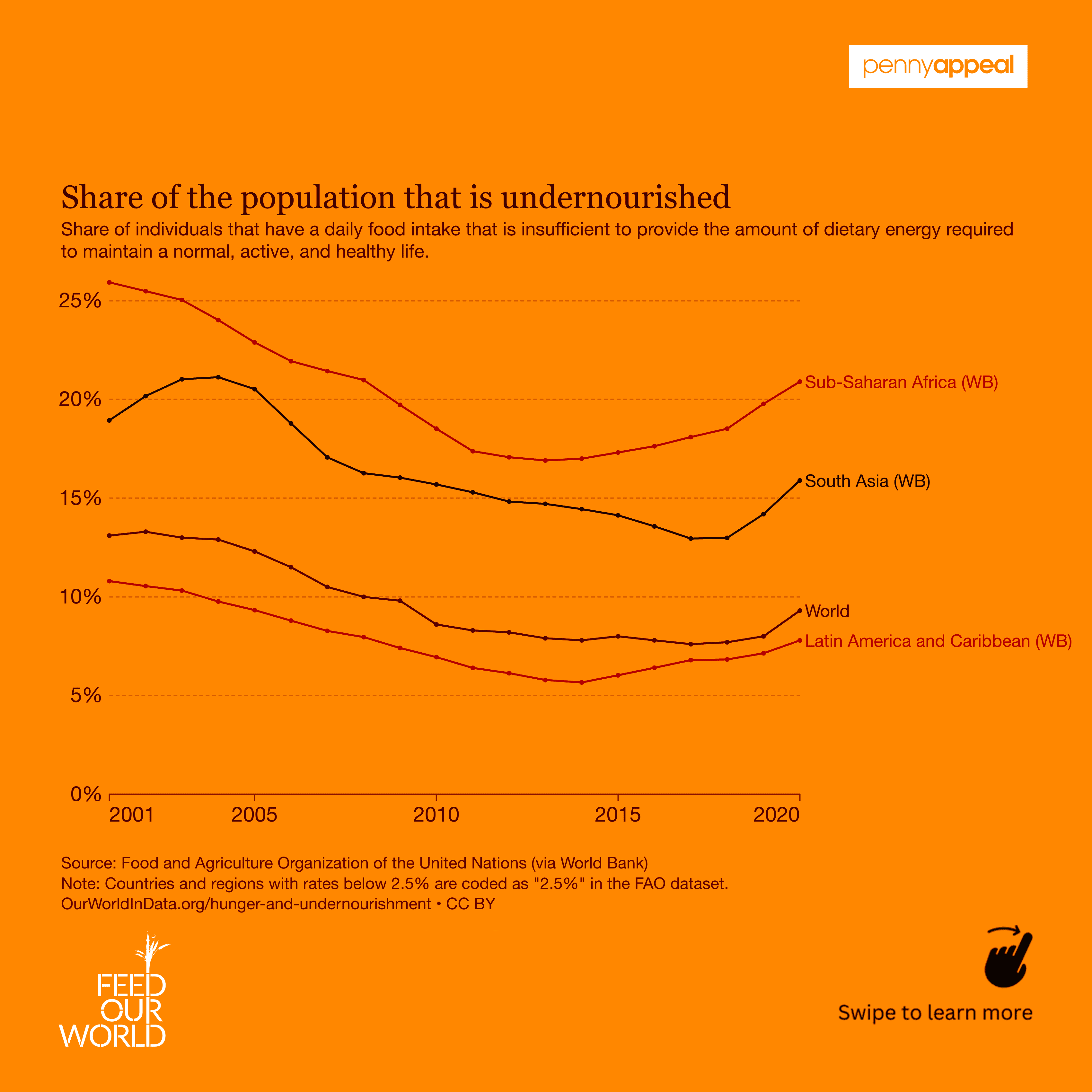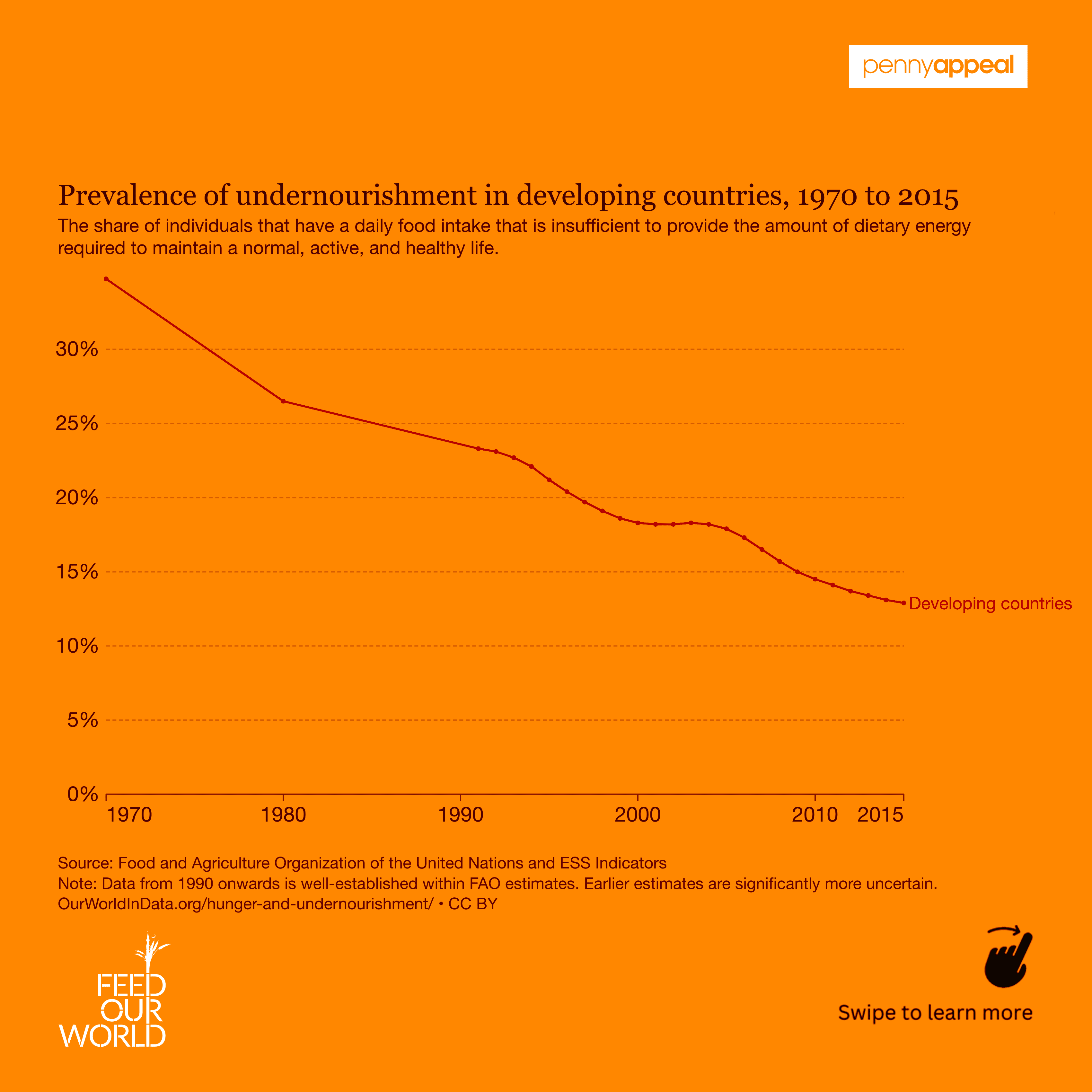Evolving Trends in the Battle Against Hunger: A Closer Examination of Progress and Challenges
In a world brimming with resources and technological advancements, a stark reality persists: nearly one in ten individuals grapples with insufficient sustenance. Hunger, or undernourishment, extends beyond physical discomfort, reflecting a fundamental injustice that restrains individuals from achieving optimal health and vitality.

Investigating the landscape of undernourishment reveals distinct patterns across regions. Sub-Saharan Africa stands as a focal point of concern, demanding targeted interventions. South Asia similarly confronts significant undernourishment, surpassing levels observed in the Americas and East Asia. North America and Europe exhibit relatively lower rates, notably hovering below the 2.5% mark.
Reflecting on the visual representation within these charts and the disparities it unearths, a resounding theme emerges – the fight against hunger is an urgent shared responsibility. While progress has been achieved, the persistence of undernourishment underscores the need for unwavering commitment, innovation, and international cooperation. Through collaborative efforts, we can pave a path toward a future where hunger is vanquished, granting each individual the dignity of adequate nourishment and the opportunity to lead a life of promise and possibility.
The Far-Reaching Consequences of Hunger: Malnutrition’s Impact on Childhood Development
Hunger and malnutrition are complex challenges that extend beyond a mere lack of food. Their effects can manifest in various ways, often resulting in dire health outcomes, especially for mothers and children. The World Health Organization (WHO) and the UN Food and Agriculture Organization (FAO) closely monitor two critical indicators of malnutrition in children: stunting and wasting.
Stunting, a phenomenon in which a child’s height is significantly below the norm for their age, serves as an illustration of how inadequate nutrition can impede growth and overall development. Beyond its immediate implications, stunting can cast a long shadow, leaving lasting repercussions that reverberate throughout an individual’s life. This can encompass not only physical stature but also cognitive development, underscoring the importance of addressing malnutrition during the critical early years of life.
Wasting, another distressing manifestation of malnutrition, pertains to a child’s weight being excessively low in proportion to their height. This condition arises from short episodes of undernutrition, leading to substantial loss of muscle and fat tissue. The gravity of wasting lies in the stark reality that these children are grappling with a severe depletion of essential resources, evident in their significantly low weight-for-height ratio.
While global efforts have made strides in tackling hunger and malnutrition, it is disheartening to note that a substantial number of children worldwide still bear the burden of malnourishment. The chart depicting rates of stunting paints a sobering picture, revealing that in some nations, over one-third to even half of all children are affected by stunting. These statistics underscore the urgency of targeted interventions to provide adequate nutrition and support to vulnerable populations, safeguarding the well-being and future potential of our youngest generation. The widespread prevalence of stunting and wasting among children serves as a reminder that the fight against hunger is not solely about addressing immediate nutritional needs; it encompasses the broader spectrum of human development and potential.
The Power of Nutrient-Rich Diets: Cost and Consequences
A healthy diet encompasses more than just calories; it involves a diverse array of nutrient-packed foods, brimming with vitamins and minerals vital for well-being. This exploration delves into the global dietary landscape, revealing a stark truth – healthy diets come at a price, costing more than four times the basic, calorie-sufficient option. This holds true worldwide, leaving a staggering three billion people unable to afford a nourishing diet, even when prioritizing food expenditures.
The significance of a healthy, nutritious diet resonates as a fundamental human need. However, billions grapple with ‘hidden hunger,’ a condition marked by micronutrient deficiencies like inadequate iron, calcium, vitamin-A, or iodine.
The barriers to a nourishing diet are multifaceted, often linked to affordability. A team of researchers embarked on an extensive endeavor to gauge the global affordability of food, seeking the most cost-effective paths to fulfill basic nutritional needs. Anchoring their efforts in the FAO’s “The State of Food Security and Nutrition in the World” report, Anna Herforth and her colleagues posed a pivotal question – how can dietary prerequisites be met in the most economical manner for each country?

Their answer emerged from a meticulous synthesis of data, where prices of locally available food items from the International Comparison Program (ICP) harmonized with other facets like food composition and dietary requirements. This nuanced approach offered insights into the intersection of affordability and nutrition, shaping a compelling narrative that underscores the challenges and imperative of fostering accessible, nutrient-rich diets for all.
The Vital Equation of Affordability and Nutrition
At the heart of sustenance lies a fundamental truth – securing enough calories is paramount. While these calories can manifest in various forms, starchy foods and cereals emerge as the most economical choice across nations. Yet, subsisting solely on this ‘energy sufficient’ diet – a monotony of maize flour or rice – unveils a dangerous reality. Notably, a closer examination of dietary patterns in low-income countries reveals a predominant reliance on starchy staples which can be detrimental to the overall health of a population.
Intriguingly, an energy sufficient diet can be sustained on less than $1 a day. The global average cost across all countries surveyed hovers at a modest $0.83 per day. Affordability, a pivotal benchmark, hinges on the yardstick of allocating 52% of one’s income to food. While subjective, this concept aligns with income disparities, mirroring Engel’s Law, where higher incomes correlate with a diminishing proportion of spending on food. This dynamic holds true across the globe.
This financial interplay underscores a sobering reality – the poorest households allocate a disproportionate share of income to food. The ‘52% threshold’ mirrors the spending patterns of those at the lowest income strata.
By aligning the cost of diets with income distributions globally, researchers projected that a staggering 381 million individuals were unable to afford the most rudimentary energy sufficient diet in 2017, representing those in the direst circumstances of nutritional deprivation.
In essence, this calorie-sufficient threshold parallels the $1.90 international poverty line, serving as an emblematic marker of dire circumstances. It embodies an uncompromising bare minimum, a beacon to identify and address the most vulnerable living at the precipice of nutritional and economic deprivation.
Mapping the Balance: Affordability and Nourishment on the Global Scale
Placing food prices in a broader context finds resonance in comparing the cost of a nutritious diet to the median income across nations. A striking revelation unfolds – in the most impoverished countries, the cost of a healthy diet surpasses the median income. A poignant truth emerges – even if every penny were devoted to food, the pursuit of a nutritious diet would remain a distant dream.
In certain countries, like India, dietary expenses teeter on par with median incomes. Here, individuals would have to allocate their entire earnings to afford a balanced diet. In contrast, the rightmost end unveils the world’s most affluent nations, where median incomes tower above dietary costs. For them, securing a wholesome diet requires a comparably minor fraction of income. In France, merely 6% would suffice, while in Denmark, a meager 5%. This comparative visual underscores a profound chasm that divides most of the globe from affordable access to nourishing diets. It underscores the infeasibility of channeling all, or even most, income into sustenance. The implications are significant – essential aspects such as energy, housing, clothing, education, and healthcare would be relegated to the sidelines.
While no definitive answer surfaces regarding the ‘right’ income level, this perspective provides a compass of understanding. It offers a glimpse into minimum benchmarks that might be considered reasonable, guided by the cost of nourishing diets worldwide. In this intricate web of affordability and sustenance, an unspoken urgency arises, urging equitable access to wholesome nutrition for every corner of the globe.
Evolving Trends in the Battle Against Hunger: A Closer Examination of Progress and Challenges
The fight against global hunger stands as a testament to humanity’s collective efforts, showcasing significant strides over the past century and beyond. Throughout the 20th and early 21st centuries, the rates of undernourishment witnessed a remarkable decline, reflecting a resolute commitment to addressing one of the world’s most pressing issues.
In 1970, the United Nations Food and Agriculture Organization (FAO) shed light on a dire reality – one in three individuals in ‘developing countries’ suffered from hunger. This alarming statistic served as a catalyst for change, propelling nations, organizations, and communities into action. The ensuing decades saw an inspiring transformation, as rates of undernourishment plummeted to 12% by 2015, painting a picture of progress that held the promise of a brighter future.
Yet, recent times have introduced nuanced dynamics into the narrative of global hunger. The FAO, an authoritative source on hunger estimates, has made noteworthy adjustments in its methodology for gauging undernourishment. Consequently, the long-term series from the 1970s, once a cornerstone in assessing progress, is no longer updated. This strategic recalibration emphasizes the need for precision and adaptability in accurately portraying the complex reality of hunger in our modern world.
The fervent pace of decline in undernourishment rates has encountered obstacles in the last decade, slowing across various regions. This observation prompts a closer examination of the intricate factors influencing this shift, ranging from economic fluctuations and geopolitical tensions to evolving dietary habits and environmental challenges. While it is heartening to acknowledge that rates of undernourishment are significantly lower than their historical counterparts, we must also acknowledge that the journey to eliminate hunger is far from complete. The progress made is a testament to the unwavering dedication of countless individuals, organizations, and policymakers. Yet, the lingering gap between current figures and the elusive goal of zero undernourishment serves as a poignant reminder that the battle against hunger demands ongoing commitment, innovation, and collaboration.
In essence, the trajectory of global hunger reflects both the triumphs of collective action and the complexities inherent in tackling such a multifaceted issue. As we navigate the evolving landscape of food security, our shared responsibility is to remain steadfast in our resolve, continuously adapt to changing circumstances, and work collectively towards a future where every individual enjoys the fundamental right to nourishment and well-being.
Sources:
Hannah Ritchie, Pablo Rosado and Max Roser (2023) – “Hunger and Undernourishment”. Pulished online at OurWorldInData.org. Retrieved from: ‘https://ourworldindata.org/hunger-and-undernourishment’ [Online Resource]
Hannah Ritchie (2021) – “Three billion people cannot afford a healthy diet”. Published online at OurWorldInData.org. Retrieved from: ‘https://ourworldindata.org/diet-affordability’ [Online Resource]
Other Recent Articles
Read from a Penny Appeal Canada team member about how we’re taking small change and making a BIG difference!

Contact our donor care team:
1-855-880-4141
Open Mon - Fri : 9:00am - 6pm EST


